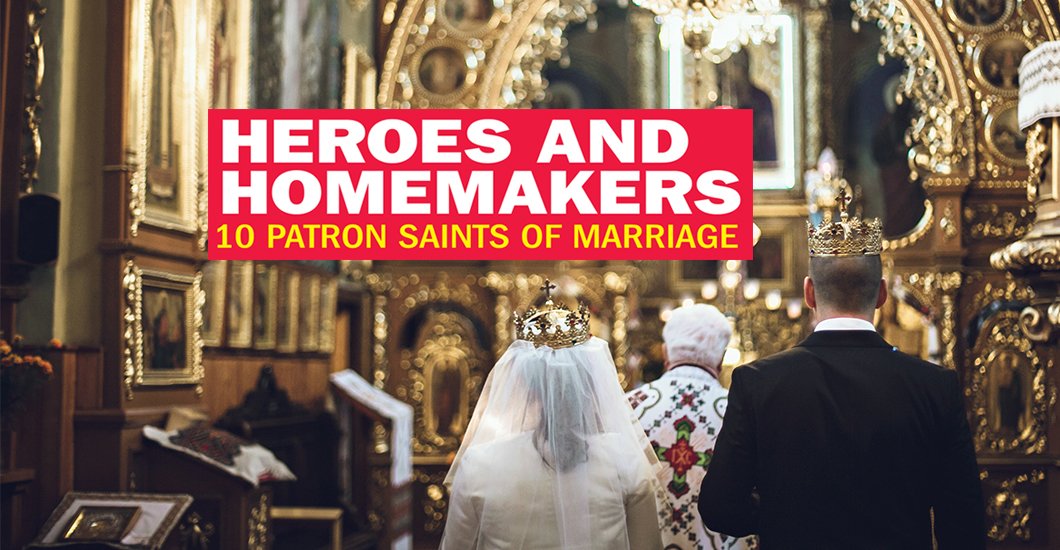Enjoy
Heroes and Homemakers | 10 Patron Saints of Marriage
There is no greater force against evil in the world, says Cardinal Raymond Burke, “than the love of a man and woman in marriage.”
Keep in mind that marriage, as a sacrament instituted by Christ, is a reflection of the exchange of love between the three persons of the Blessed Trinity. Because of this, marriage is under attack, perhaps in a way that it has never been before. We should pray for married couples, that they may receive abundant graces to live out their vocations in fullness. As married couples, we should turn to prayer each day to seek renewed strength and love from God. We should also celebrate Catholic weddings as a reverent and joyous occasion. Do you know who the patron saint of marriage is? Actually, that is a bit of a trick question, because there are more than one. Some are patrons of specific situations within marriage, which might make one of them in particular a very fitting intercessor for your needs.
Saint Adelaide of Burgundy: Patron Saint of Second Marriages
Saint Adelaide, born around 931 AD, was daughter to the king of Burgundy and “one of the most influential women of 10th-century Europe.” Her first husband, Lothair, is believed to have been killed by enemies of his throne. Later, it seems that Otto, the emperor of Germany, fell in love with Adelaide and married her. Together they had five children. She was widowed twice, since Otto died long before she did. During the course of her life she was imprisoned, forced from her throne, held in solitary confinement and treated with contempt by certain family members. Throughout all of this, she remained humble and gentle, giving her life to the Church and her people. She founded many monasteries and churches and was overwhelmingly generous to the poor, even to the point of putting the kingdom’s treasury at risk. She died on December 16, 999.
Saint Gengulphus of Burgundy: Patron Saint of Difficult Marriages
Saint Gengulphus is a little-known saint who has been called a great miracle worker. He was a knight who served King Pepin the Short in the eighth century. One story told about the saint is how his sanctity was revealed to the king when a lamp continued to miraculously rekindle beside him as he slept. Though he was renowned for his great charity and piety, his own wife was unfaithful to him and he was murdered at the hands of her lover. There are not many details known about his life, but a certain Gonzo of Florence wrote that, “This blessed Gengulphus daily performs among us so many remarkable miracles that, were he alive today, even the swift pen of the poet Thespis could not have described them individually.” His feast day on the Roman calendar is May 11.
Saint Joseph: Patron Saint of Married People
It will come as no surprise to us that we can turn to Saint Joseph as a patron of married couples. There is not a better earthly exemplar of Saint Paul’s teaching: “Husbands, love your wives, even as Christ loved the church and handed himself over for her …” (Ephesians 5:25). Archbishop Fulton Sheen wrote a beautiful book called, “The World’s First Love.” In it there is a chapter called “The World’s Happiest Marriage,” in which he speaks of Joseph and Mary. “No husband and wife ever loved one another so much as Joseph and Mary …” writes Sheen. “But in the case of Mary and Joseph, there was no need of the symbol of the unity of the flesh, since they already possessed the Divinity.” Theirs was a virginal marriage, but a true, happy marriage. Who does not want a happy, holy marriage? Turn to Saint Joseph as intercessor. He is said to be the most powerful saint in heaven after Our Lady. March 19 is the feast of Saint Joseph, husband of Mary.
Saint Monica: Patron Saint of Married Women
Saint Monica was born in the fouth century to a wealthy Christian family. They may not have been particularly devout, however, for when she came of age, they married her to a pagan Roman official, Patricius. He was infamous for his “violent temper” and “dissolute habits.” Though irritated by Monica’s faith and by her devotional practices, he did respect her. Saint Monica suffered greatly on behalf of the godless lifestyles of her husband as well as her son (who we now know as Saint Augustine) but she wept, prayed and fasted on their behalf, begging God for their conversion. Her prayers would be answered. Her husband was baptized a year before his death, and although it was much longer before Augustine converted, he would become one of the greatest saints in the Church. Almost everything that we know about Saint Monica we have learned from his classic book, “The Confessions of Saint Augustine.” Her feast day is May 4.
Saint Priscilla: Patron Saint of Good Marriages
Saint Priscilla and her husband Saint Aquila were Jewish converts to Christianity. It appears that their conversion was brought about when they met Saint Paul. We know about them from the Sacred Scriptures (read the Acts of the Apostles, Chapter 18 for starters) and here is something beautiful: their names are always mentioned together, never separately. This reveals the unity lived out in their marriage. They were tentmakers by trade (as was Saint Paul) and were some of the earliest Christian missionaries. They were martyrs for the Faith, and their feast day is celebrated on July 8.
Saint Rita of Cascia: Patron Saint of Difficult Marriages
Saint Rita was born in Italy to devout parents in 1381. When she grew up, Rita desired to become a nun, but her parents arranged for her to marry a man named Paolo Mancini, with whom she would have two sons. It seems that Paolo was a complicated man (and there are varying accounts of his character) but we do know that Rita suffered during her marriage. Paolo was impetuous and had a fierce temper and seems to have been irresponsible with gaming and debts. Violent conflicts between noble Italian families were common at this time and Paolo was involved in these feuds. He was rough with Rita and may even have been physically abusive. In spite of all this, she exercised the virtues of patience and humility toward him and was a truly loving and faithful wife and homemaker. Over time, her love, example and prayers bore fruit and Paolo’s heart began to undergo conversion. (One biographer writes that he would become ashamed of his temper when it got the best of him and rush out of the house, returning only when he had calmed down.) Paolo did have enemies, who eventually ambushed and killed him. His sons wanted to avenge his death, but Rita tried to dissuade them; finally, she begged God to take the lives of her sons rather than allow them to commit a mortal sin which would endanger their salvation. Both sons did pass away from an illness and were prevented from acting in violence. Rita subsequently entered an Augustinian order of nuns. She died in 1457. Her feast day is May 22.
Saint Thomas More: Patron Saint of Difficult Marriages
Saint Thomas More was born in England in 1478. He is a well-known and beloved saint who was a husband, father, statesman and renowned lawyer. Sir Thomas was a just man who was brilliant and blessed with innumerable talents. He married a gentlewoman by the name of Jane Colt. They had a four children and theirs was a happy marriage; but sadly, she died very young. Thomas More married again. His second wife was Alice Middleton. Though she was of a different temperament than Jane, who was so quiet and meek, we are told that this second marriage was also a very happy one. Thomas More was a devoted husband and loving father. Why is he a patron saint of difficult marriages, if both his marriages were happy ones? The reason is due to his opposing King Henry VIII’s divorce, which would eventually lead him down the path of martyrdom. After his trial, he was officially condemned to death for his refusal to acknowledge the king as the head of the Church in England. Saint Thomas More’s feast day is June 22.
Saint Valentine: Patron Saint of Happy Marriages
There is very little known about Saint Valentine, who lived in the third century under the reign of Claudius Gothicus. It is understood that he was a priest (possibly even a bishop) who was martyred; his remains were buried along the Via Flaminia in Rome. Recent archaeological finds have proven that he lived: the remains of catacombs and a church dedicated to him have been unearthed. There are two legends as to why he was martyred, which might be due to the fact that there may have been more than one “Valentine” and their stories were mixed. One legend says that he was executed for giving aid to Christians. Another legend says that the emperor Claudius had banned marriage in order to obtain more soldiers for his army, since married men with wives and children would be less willing to die in battle. Thus it is said that Saint Valentine married couples in secret and was eventually found out. Various churches today have relics from him, including his skull. He was canonized in 496, but his feast was removed from the general Roman calendar in 1969 due to the resulting confusion over the years of possibly three or four Valentines being treated as one person. However, in various localities the Church still celebrates his feast day, which is, of course, February 14.
Saints Louis and Zelie Martin
Saints Louis and Zelie Martin are the first married couple to be canonized together. They lived humble, ordinary lives, in which both suffering and joy played important parts. Together they bore nine children, but only five survived childhood. Each of these five daughters would eventually enter the religious life. One of them is well known to us: Saint Therese of Lisieux, called “The Little Flower.” It is usually the case that we allow ourselves to be overwhelmed by the lives of “great saints”; we feel that they are super humans whom God has called in a special way and that He does not mean for us to attain such a level of sanctity. This is not the case. Simply by cooperating with God’s grace in our particular state in life we can be deeply purified and closely aligned to Our Lord and His loving will. Louis and Zelie are perfect examples for us. They faithfully fulfilled their roles as spouses and parents and through their quiet lives of love, service and self-sacrifice, God brought them home to Himself. In his homily for their canonization Pope Francis said, “The holy spouses Louis Martin and Marie-Azélie Guérin practiced Christian service in the family, creating day by day an environment of faith and love which nurtured the vocations of their daughters …” Although it has not been officially stated that they are patron saints of married couples, they are beautiful examples of the vocation of marriage expressed in all its fullness, and we can certainly imitate their virtues and seek their intercession. Their feast day is July 12.
… And Other Wonderful Saints
If you are reading this, and you are a single man or woman hoping to meet your future spouse, remember that there are patron saints for you, as well! Saint Ann, the mother of the Virgin Mary, has long been a faithful intercessor for young women who pray for a husband. Saint Nicholas, Bishop of Myra (who is usually forgotten outside of the Christmas season) is the patron of young people seeking a husband or wife. This is because of an incident in his own life in which he provided a dowry for three poverty-stricken sisters so that they could marry.
Genevieve Cunningham works for The Catholic Company. She is the second oldest of nine children. Genevieve studied writing in college and spent a few years discerning with a cloistered order of nuns before joining The Catholic Company. Originally from Pennsylvania, she lives in North Carolina, where she manages email marketing and occasionally writes for GetFed. Originally published at GetFed.com, a service of The Catholic Company (CatholicCompany.com). Reprinted with permission.
Related Articles
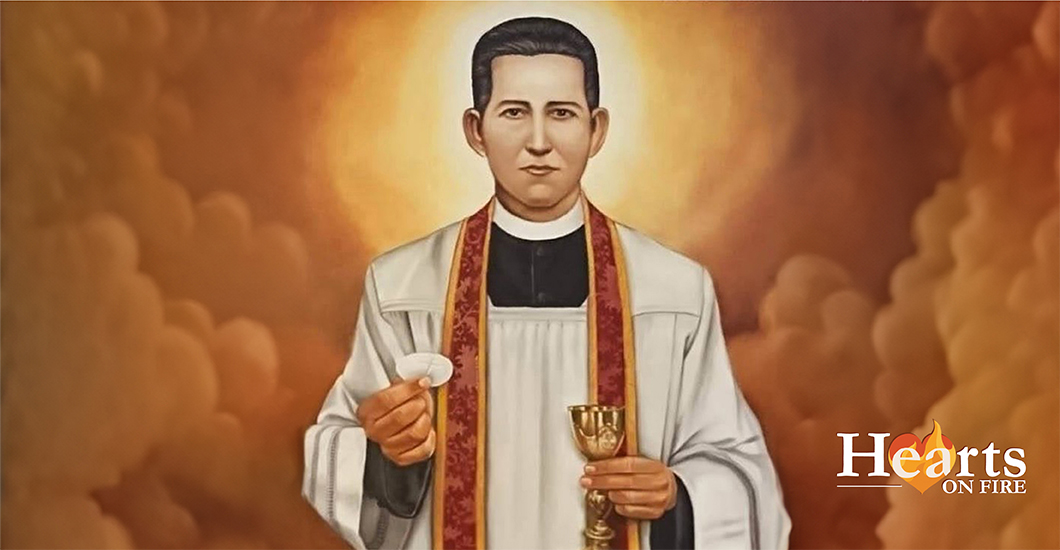
Aug 23, 2024
Encounter
Aug 23, 2024
The Mexican Revolution which began in the early 1920s, led to the persecution of the Catholic community in that country. Pedro de Jesus Maldonado-Lucero was a seminarian at that time. Once he became a priest, despite the risk, he stood with his people. He tended to his flock during a terrible epidemic, founded new apostolic groups, reestablished associations, and ignited Eucharistic piety among his parishioners.
Upon discovering his pastoral activities, the government deported him, but he managed to return and continue serving his flock, in hiding. One day, after hearing the confessions of the faithful, a gang of armed men busted his hiding place.
Father Maldonado managed to grab a reliquary with Consecrated Hosts as they forced him out. The men forced him to walk barefoot throughout the town, as a crowd of the faithful followed him. The city mayor grabbed Father Maldonado's hair and dragged him toward the city hall. He was knocked to the ground, resulting in a skull fracture that popped out his left eye. He had managed to keep his grip on the pyx until this time, but now it fell out of his hands. One of the thugs took some Holy Hosts, and as he forcefully stuffed the hosts inside the priest’s mouth, he shouted: “Eat this and see if He can save you now.”
Little did the soldier know that just the night before, during the Holy Hour, Father Maldonado had prayed that he would happily give his life for an end to the persecution ‘if only he would be allowed to take Communion before his death.’
The thugs left him for dead in a pool of his own blood. Some local women found him still breathing and rushed him to a nearby hospital. Father Pedro Maldonado was born into eternal life the next day, on the 19th anniversary of his priestly ordination. Pope John Paul II canonized this Mexican priest in 2000.
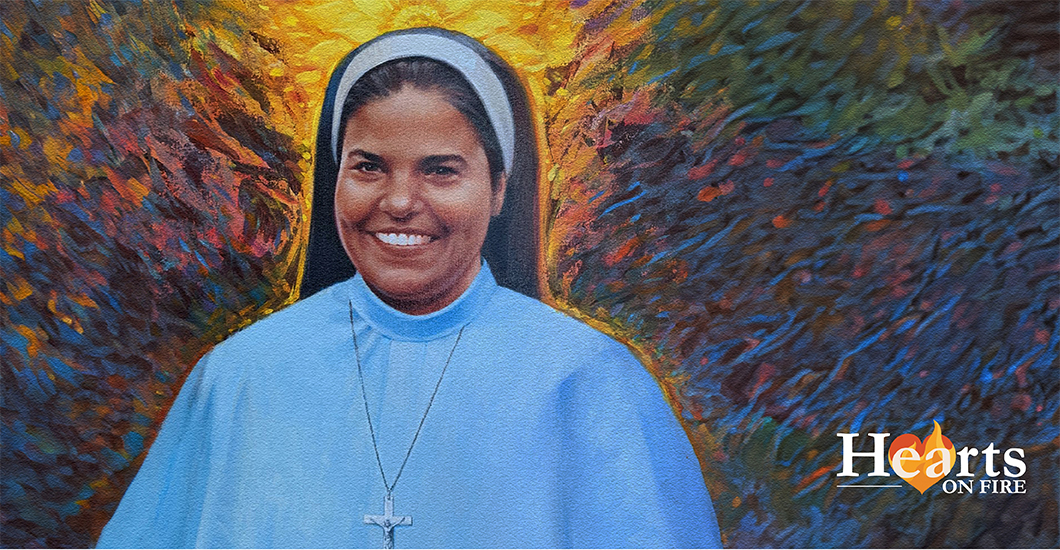
Jun 27, 2024
Enjoy
Jun 27, 2024
Rani Maria Vattalil was born on 29 January 1954 to Eleeswa and Paily Vattalil in a small village called Pulluvazhy, in Kerala, India. From a young age, she was brought up in the Christian faith, having love for the poor. She attended daily Mass and led family prayers. During the final year of high school, Rani felt the Lord calling her to consecrated life and entered the Franciscan Clarist Congregation in 1972. It was Rani Maria’s ardent desire to do missionary work in North India and serve the poor, even if it cost her life. She was sent to Madhya Pradesh (a central Indian state) and served several mission areas there.
Sister Rani Maria was given the responsibility of coordinating the social apostolate of the local diocese. She organized various educational programs for children and young people and worked relentlessly to empower the indigenous people. She understood how the poor, illiterate farmers were exploited and taken advantage of by their landlords. So, she educated them on their rights, helped them fight for justice, and spoke for those who were unjustly imprisoned. All this infuriated the upperclass landlords, who threatened her with dire consequences if she continued supporting the cause of the poor. But Rani Maria feared nothing and did not back down from her mission to 'love her neighbor.' A devious plan was then hatched by those who hated her.
On 25th February 1995, while traveling by bus, she was mercilessly stabbed 54 times by Samundhar Singh—a man hired by the landlords. She breathed her last, repeating the Holy name of Jesus. Rani Maria worked her entire life to fight for the dignity and rights of her fellow men and bore witness to the Gospel through her social activities. Sister Rani Maria’s family, following the valiant example of their daughter, forgave her murderer wholeheartedly, even inviting him to their home! This act of mercy touched him deeply; he repented of his heinous crime and became a changed man.
Sister Rani Maria was beatified by Pope Francis on 4th November 2017.

Apr 29, 2024
Encounter
Apr 29, 2024
Martin de Porres was born in 16th-century Peru; he grew up facing the stigmas of both his mixed race and illegitimacy. After a barber-medical apprenticeship in his young years, he joined the Dominicans as a ‘lay helper’ and continued his barber work in the monastery.
One day, Brother Francis Velasco Carabantes approached Martin, desiring to talk to this man whom people were already starting to believe was saintly. Martin was busy with his barber work; he absent-mindedly grabbed this novice and placed him in the barber’s chair. Brother Francis had no inclination to have his head shaved; he disliked the hairstyle that the Dominicans used.
Before he could resist, Martin had finished his job, and Brother Francis was angry beyond expression. He started to shout, calling Martin all sorts of curse words. Martin was lost in prayer, and by the time he noticed that this novice was shouting, one of the rectors had seen the commotion and was scolding Brother Francis, who was severely punished and sent away.
Martin, once he came to realize what had happened, went to the rector with all possible excuses. He begged forgiveness for this person who had verbally abused him, trying even to explain away the curse words used. Finally, he told the rector: “Everyone knows what a sinner I am.” The rector, who was aware of Martin’s saintly life, gave in to his request and forgave Brother Francis. Not satisfied with this, Brother Martin even sent fresh fruit, which was a rare delicacy in the monastery, to Brother Francis.
How many times have we rejoiced in the ‘just’ punishments that our transgressors received? Let us pray to Saint Martin for the virtue of humility, to forgive and show the other cheek, as Jesus taught us to do.

Dec 12, 2023
Encounter
Dec 12, 2023
On a scorching afternoon on the streets of Calcutta, I met a boy…
Prayer is an undeniable, central, and key part of every Christian’s life. However, Jesus emphasized two more things which clearly went hand in hand with prayer—fasting and almsgiving (Matthew 6:1-21). During the seasons of Lent and Advent, we are specifically called to commit more time and effort to all three ascetic practices. ‘More’ is the important word. Whatever season we are in, radical self-denial and giving are a continuous call for each baptized believer. Around eight years ago, God literally made me stop and think about it.
Unexpected Meeting
In 2015, I had the great privilege and blessing of fulfilling a lifelong dream to be with and serve some of the most in-need brothers and sisters worldwide in Calcutta, India, where the poor are described not only as poor but the ‘poorest of the poor.’ From the moment I landed, it was as though electricity was running through my veins. I felt such immense gratitude and love in my heart to be given this amazing opportunity to serve God with Saint Mother Teresa’s religious order, the Missionaries of Charity. The days were long but absolutely action-packed and grace-filled. Whilst I was there, I did not intend to waste a moment. After a 5 AM start to each day with an hour of prayer, followed by Holy Mass and breakfast, we set off to serve at a home for the sick, destitute, and dying adults. During the break at lunchtime, after a light meal, many of the religious brothers I was staying with took a siesta to recharge their batteries, to be ready to go again in the afternoon and on into the evening.
One day, instead of having a rest in the house, I decided to go for a walk to find a local internet café, to contact my family by email. As I turned one of the corners, I encountered a young boy aged around seven or eight years old. His face expressed a mixture of frustration, anger, sadness, hurt, and tiredness. Life had already seemed to have begun to take its toll on him. He was carrying over his shoulder the biggest transparent, heavy-duty plastic bag that I had seen in my life. It contained plastic bottles and other plastic items, and it was full.
My heart broke within me as we stood silently examining one another. My thoughts then went to what I could give this young boy. My heart sank, as I reached for my pocket, realizing that I only had a small amount of change with me to use for the internet. It added up to less than one pound in English money. As I gave it to him, looking him in the eye, his whole being seemed to change. He was so lifted and grateful, as his beautiful smile lit up his beautiful face. We shook hands, and he walked on. As I remained standing in that back street of Calcutta, I stood in awe as I knew that the Almighty God had just personally taught me such a powerful life-changing lesson through this encounter.
Reaping Blessings
I felt God had beautifully taught me in that moment that it is not the actual gift that is important but the disposition, intention, and love from the heart with which a gift is given. Saint Mother Teresa beautifully summed this up saying, “We cannot all do great things, but we can do small things with great love.” Indeed, Saint Paul said, if we give away all we have “but have not love,” we gain nothing (1 Corinthians 13:3).
Jesus describes the beauty of giving, that when we “give… it will be given to you; good measure, pressed down, shaken together, running over, will be put into your lap. For the measure you give will be the measure you get back.” (Luke 6:38). Saint Paul also reminds us that “Whatever a man sows, that he will also reap” (Gal 6:7). We do not give in order to receive, but God in His infinite wisdom and goodness blesses us personally in this life and also in the next when we step out in love (John 4:34-38). As Jesus taught us, “it is more blessed to give than to receive” (Acts 20:35).
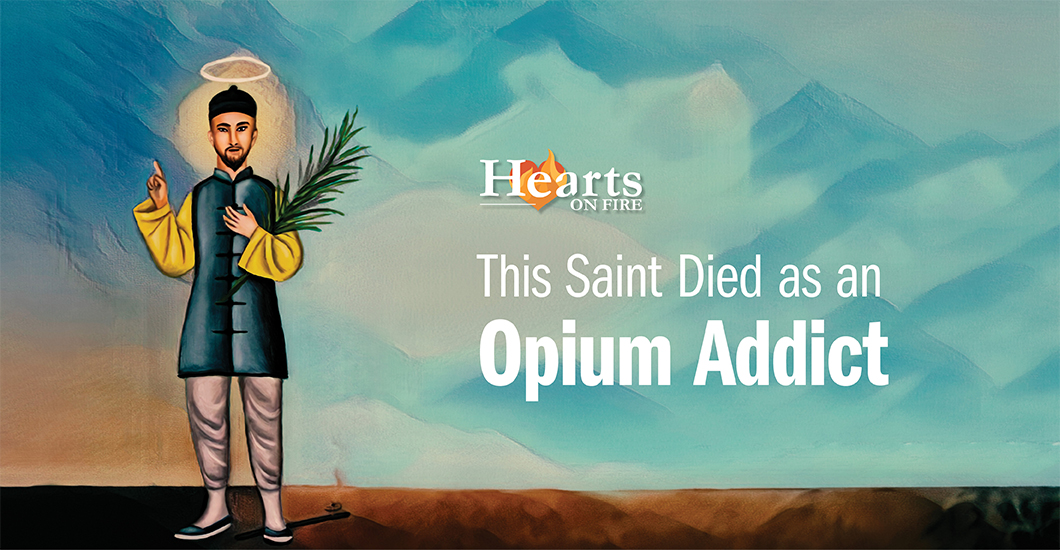
Nov 01, 2023
Engage
Nov 01, 2023
The Chinese Boxer Rebellion in the 1900s killed nearly 32,000 Chinese Christians and 200 Western Missionaries. Among these devoted Christians who gave their life for their faith, Saint Mark Ji Tianxiang stands out because, at the time of his death, he was an opium addict who had not received the Sacraments for 30 long years.
Ji was raised in a devout Christian family, and he was a respected and charitable doctor in his community. Fate be blamed, the opium he took to abate a disturbing stomach ailment took hold over him, and he was addicted to it in no time.
Though he went to frequent Confession, Ji found himself in the grips of a powerful addiction that refused to succumb to any means of resistance. His parish priest and confessor eventually told him that he could not continue to repeat the same sin in Confession anymore. Confession requires a conscious resolve to repent and sin no more, and this repeated sin, in the 19th century, was not understood as an illness. He was henceforth restricted from receiving the Sacraments, but he continued visiting the Church and stayed true to the Lord’s ways. He remained sincere to his faith because He believed in a Merciful Father.
Many assumed that he would be the first to deny the Lord when faced with the threat of persecution. But along with his son, grandchildren, and daughters-in-law, he persevered till the very end. In fact, Ji provided spiritual consolation to his fellow Christians as they were imprisoned and awaiting execution.
Stories record that as they were dragged to prison, his grandson, shaking with fear, asked him, “Grandpa, where are we going?” He calmly and jubilantly answered: “We’re going home.” He went to his death, singing the Litany of the Blessed Virgin Mary. Pope John Paul II canonized him in the year 2000.
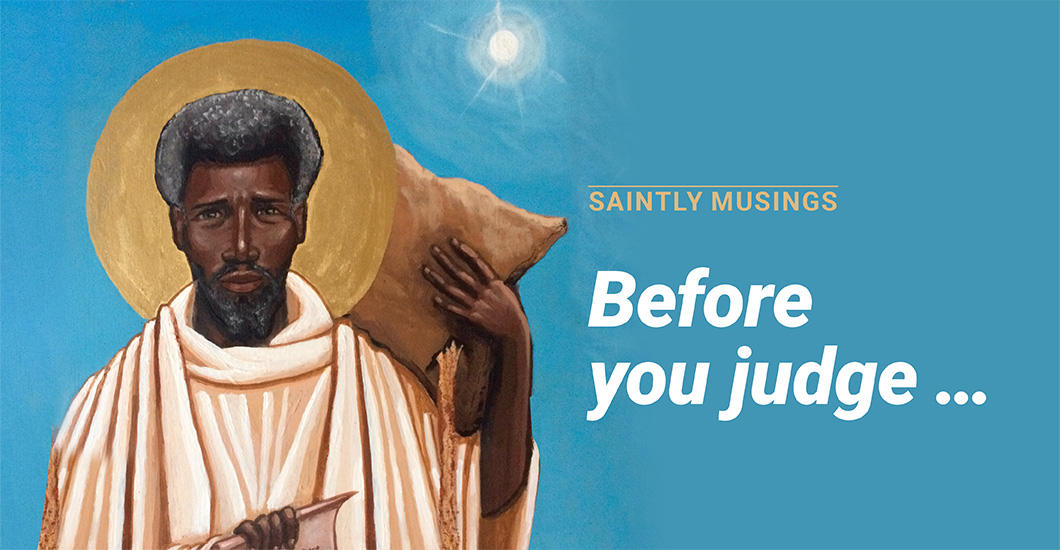
May 31, 2023
Engage
May 31, 2023
Ever heard of a robber who turned into a Saint? Moses the Black was a leader of a band of thieves who attacked, robbed, and murdered travelers in the Egyptian desert. The very mention of his name spread terror in people’s hearts. On one occasion, Moses had to hide in a monastery and was so amazed at the way he was treated by the Monks that he converted and became a monk! But the story doesn’t end there.
Once, four of the robbers of his former band descended upon the cell of Moses. He had lost none of his great physical strength, so he tied them all up. Throwing them over his shoulder, he brought them to the monastery, where he asked the Elders what to do with them. The Elders ordered that they be set free. The robbers, learning that they had chanced upon their former ringleader and that he had dealt kindly with them, followed his example: they repented and became monks. Later, when the rest of the band of robbers heard about the repentance of Moses, they also gave up their thievery and became fervent monks.
After many years of monastic struggles, Moses was ordained deacon. For another fifteen years, he continued his monastic labors. About 75 disciples gathered around the saintly Elder, who had been granted the gifts of wisdom, foresight, and power over demons by the Lord.
Once, a certain brother committed an offense in Scete, the camp of the monks. When a congregation was assembled to decide on this matter, they sent for Abba Moses, but he refused to come. Then they sent the priest of the church to him, imploring, “Come, for all the people are expecting you,” and finally, he responded to their pleas.
Taking a basket with a hole in it, he filled it with sand and carried it upon his shoulders. Those who went out to meet him asked, “What does this mean, O Father?” And he replied, “The sands are my sins, which are running down behind me, and I cannot see them. Yet, I have come here today to judge shortcomings that are not mine.” When they heard this, they set that brother free and said nothing further to him.

Mar 01, 2023
Engage
Mar 01, 2023
At the age of 20, Anthony lost his parents and was left with a large inheritance and the responsibility of caring for his sister. About the same time, Anthony happened to hear a reading from the Gospel of Matthew, where Jesus tells a rich young man, "If you want to be perfect, go and sell everything you have and give the money to the poor." Anthony believed he was that rich young man. Shortly after, he gave away most of his property, sold almost everything else, and kept only what he needed to care for himself and his sister. But that’s not exactly what the Lord had commanded!
Not long afterward, Anthony was at Mass once again and heard the Gospel passage, “Do not worry about tomorrow; tomorrow will take care of itself” (Matthew 6:34). Again, he knew Jesus was speaking directly to him, so he gave away even the little he had saved, entrusted his sister to the care of some holy women, and entered the desert to live a life of poverty, solitude, prayer, and mortification.
In that harsh desert landscape, the devil attacked him in countless ways saying “Think about all the good you could have done with that money you gave away!” Firm in prayer and mortification, Anthony fought off the devil and his manifestations. Many were attracted to his wisdom, and these he encouraged to seek self-denial and the hermetic life. No wonder after his death he became Saint Anthony the Great or Saint Anthony of the Desert, the father of Christian Monasticism.
Once a brother renounced the world and gave his goods to the poor, but he kept back a little for his personal expenses. He went to see Abba Antony. When he told him this, the old man said to him, "If you want to be a monk, go into the village, buy some meat, cover your naked body with it and come here like that." The brother did so, and the dogs and birds tore at his flesh. When he came back the old man asked him whether he had followed his advice. He showed him his wounded body, and Saint Antony said, "Those who renounce the world but want to keep something for themselves are torn in this way by the demons who make war on them."

Jan 14, 2023
Engage
Jan 14, 2023
Few Saints of the Catholic Church have captured the popular imagination like Joan of Arc. Her story is depicted in paintings, sculptures, and numerous films.
Born into a peasant family in 1412, Joan grew up illiterate, but acquired a profound love for the Church and a deep faith in God from her mother. Because she loved prayer and the sacraments, her neighbors said, “She was so good that all the village loved her.” She cared for the sick and homeless, often even giving them her own bed.
By the age of thirteen, Joan began to hear the voices of Michael the Archangel, Saint Margaret of Antioch, and Saint Catherine of Alexandria. They told her she was to liberate France and ensure the French heir to the throne was installed as France’s rightful king. She won his trust by telling him details of his past only someone with divine knowledge could know. At the time, France was dominated and ruled by England.
Convinced that her “voices” came from God, Joan heroically and faithfully obeyed their instruction, despite obstacles and suffering. Prayer and contemplation remained primary in her life even as she led battles, during which she never raised the sword against an enemy
Though two years earlier a commission had “declared her to be of irreproachable life, a good Christian, possessed of the virtues of humility, honesty and simplicity”, Joan was accused of witchcraft and heresy after the English captured her, receiving no support from the very King she put on the throne. At her trial, Joan manifested her deep faith and wisdom, and despite being wrongly condemned, she never lost her faith in God or the Church. When she was burned at the stake, she proclaimed the name of Jesus while holding a crucifix to her heart, causing an observer to say, “We have burned a saint.”
Her death increased her fame and popularity. Twenty years later, a new trial declared her innocent of all her alleged crimes. After her reputation grew over the centuries to epic proportions, Joan was beatified in 1910 by Pope Pius X and canonized eleven years later by Pope Benedict XV. She is now the patron Saint of France and one of the Church’s most beloved Saints.
Joan’s obedience to God ensured France kept the Catholic faith during the Protestant Reformation while England abandoned it. France remained a solid center of Catholicism from which it would spread to northern Europe.
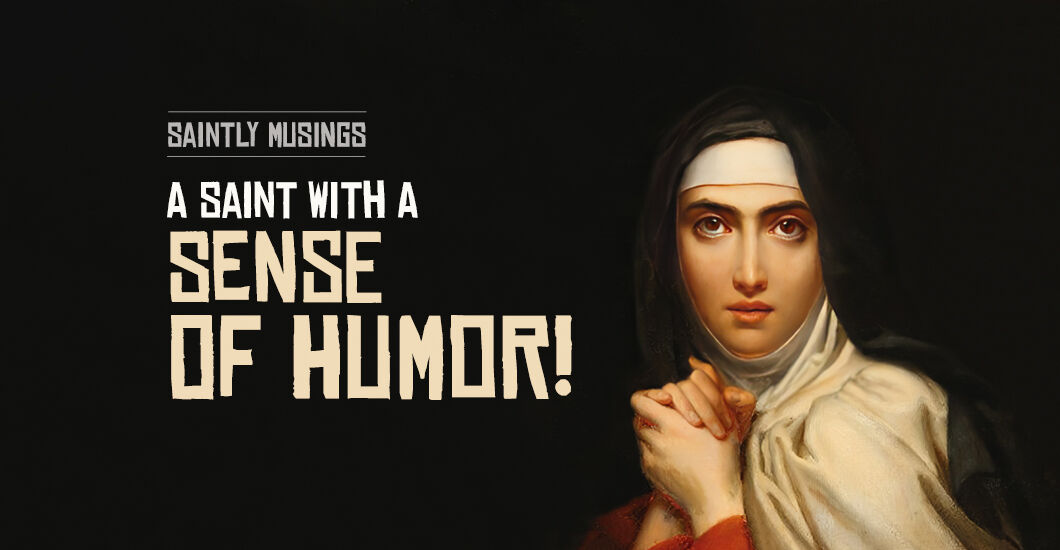
Jan 03, 2023
Engage
Jan 03, 2023
The river had swelled so high that water covered everything and all sense of where the road or footpath might be was purely a guess. With water everywhere, it seemed foolish to advance, especially in a carriage, for if anyone strayed ever so little off the road, they would perish without a doubt.
As her companions panicked, Sister Teresa encouraged them, “As we are engaged in God’s work, how could we die in a better cause?” She then led the way on foot to the convent through the fierce storm. Suddenly she slipped down an embankment and fell squarely into the mud.
Instead of complaining or cursing, the irrepressible nun, looked to the sky and quipped, “If this is how you treat your friends, no wonder you don’t have many!” The sixteenth-century Saint and Doctor of the Church, Teresa of Avila, didn’t take herself or this world too seriously and brushed off the little hardships of life with a sense of humor.
Her ability to humbly recognize her own faults and need for grace was also tinged with her refreshing humor. In her autobiography, Teresa writes, “Having virtuous and God-fearing parents would have been enough for me to be good if I were not so wicked.” Saint Teresa was also mindful of false piety and once said, “From silly devotions and sour-faced saints, good Lord, deliver us!”
A healthy and good sense of humor will keep our head straight and enable us to see the world’s true beauty. Did God say that we need to be “sour-faced” to be holy? So, if you want to become a saint, lighten up, share the joy of the Lord and laugh with your friends like Jesus did.
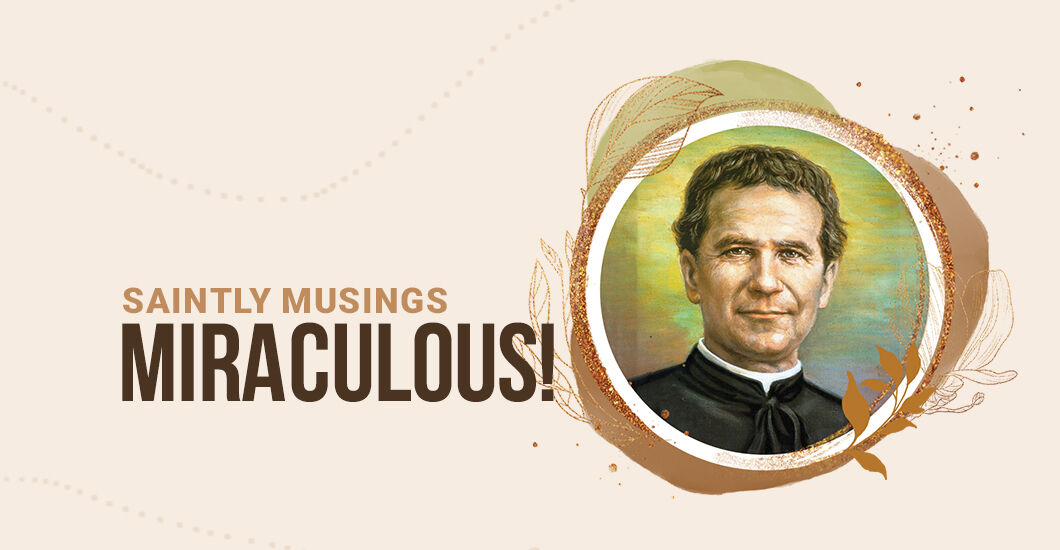
Nov 01, 2022
Enjoy
Nov 01, 2022
Maria Stardero, a 12-year-old girl, was led by her aunt into the church where dozens of boys were standing about or kneeling in prayer as they waited for Don Bosco to arrive for confessions. As she made her way to a pew, some of the boys noticed that the young girl’s eyes had no corneas and resembled white marbles.
When Don Bosco arrived, he asked the girl about her condition. She had not been born blind, she told him, but because of eye disease she had completely lost her sight two years earlier. When he inquired about medical treatment, her aunt began to sob. They had tried everything, but doctors had only one thing to say: “It is incurable!”
“Can you tell whether things are big or small?” Don Bosco asked the child.
“I can’t see anything.”
He led her to a window to see if she could perceive light, but she couldn’t.
“Would you like to see?” Don Bosco asked.
“Oh, yes! It’s the only thing I want,” said the girl, breaking down in tears.
“Will you use your eyes for the good of your soul and not to offend God?”
“I promise I will, with all my heart!”
“Good,” said Don Bosco. “You will regain your sight.”
After recourse to Mary, Help of Christians, Don Bosco recited the Hail Mary and blessed the girl. Then holding a medal of Mary Help of Christians before the girl’s eyes he asked, “For the glory of God and the Blessed Virgin, tell me what I’m holding in my hand.”
“She can’t . . .” the elderly aunt began, but Don Bosco paid no heed. After a few seconds, the child shouted, “I see!” Immediately she described the medal in great detail. But when she stretched out her hand to receive it, it rolled into a dark corner.
The aunt moved to retrieve it, but Don Bosco motioned her back.
“Let her find it to see if the Blessed Virgin has thoroughly restored her sight,” he insisted. Immediately, the girl walked to the dark corner and bent down to retrieve the tiny object. As the many witnesses looked on, awed and profoundly moved, Maria, thanked Don Bosco profusely and with sobs of great joy.
Entrust everything to Jesus in the Blessed Sacrament and to Mary, Help of Christians and you will see what miracles are! Saint John Bosco
